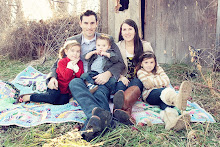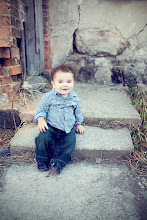Since November our household has been chaos and part of the problem is that Trent and I have slacked in the parenting department and just let the kids run loose but not too loose. I've been more snappy at my kids and more irritable with them as well and I truly want to change and have been reading and praying alot for help and direction to overcome this barrier. I keep blaming me being pregnant but I can't do that to myself anymore. It has got to STOP!
Through all my readings I've been lead to a simple discovery that has changed my life: Parenting is supposed to be hard because it’s a process that challenges me to become my best self.
So I read about BRIDGE- it's about making a Bridge from chaos and misdirection to understanding and peace.
B- Breathe. Breathe deeply to move from the automatic, reactive self that is the first to hit the scene under stressful situations. Find that place of centered peace that is the most empowering to draw strength from to effectively problem solve and teach kids a better way. Help kids to calm down too! Calming under stress is a difficult skill to master, and gets easier and faster with practice... more on this later.
R- Reflect. Provide an accurate, undramatic mirror of what just happened by describing the child's actions: You pushed the chair over /You hit me/You threw the bowl on the ground /You are crying. Since young kids usually don't have the words to describe or explain what they did I've found it's helpful to then say what their intention might have been: You were trying to get his attention/You are tired of waiting/You wanted me to know you didn't like what I said/You seem angry and hurt. Reflection can be validating, it focuses on identifying and solving the problem instead of making the child feel they are the problem. It gives words to feelings, providing a safer release for them. Questions like: "Why did you hit your brother?" "Why are you crying?" put kids on the defensive and make problem-solving harder.
I- Invite a Response. After reflection, invite the child to talk now to get clearer picture of what they were trying to do and help them understand their own actions better. Sometimes silence invites a response. Sometimes asking "Is that right?" or "Is that what happened?" Sometimes I get their intention wrong and they correct me. I've been amazed at the things I've learned here, most of the times my kids were trying to do really legitimate things but it got misdirected. Even my little 2yr old little boy could say "Daddy sleeping" and I can deduce the rest. Sometimes it's hard to get a response. It takes time, the child needs to feel safe in order to talk. Putting out their own words is a skill they need to develop. Sometimes kids respond by crying harder, or wanting a hug, or nodding. Any response is a start. Sometimes the Reflect/Invite-Listen cycle can repeat a few times until all the information has been presented. We try to get it out there. When we go back to Reflect sometimes I find it's also helpful to Reassure- I have a hard time waiting too. and I don't like it when someone has something I want too. Sometimes though my kid was just being a stinker. There was no positive intention behind their motivations. They can learn from that too.
D- Direct a new course of action. When the child feels safe, validated, and their emotions have been understood this is the golden teaching moment, the opportunity for growth that is parenting at its finest. It's best if the child can direct their own course- I can ask him for a turn. I can wait until tomorrow when the show is on again. I can tell him I was trying to build a building. But while they're learning, I help them find a solution: You may not hit, look at how much that hurts your brother. When you want the toy say "Can I play with it when you're done?" or You may not push- your brother is so sad because that hurt. When you want his attention say "let's go play together" or We have to be patient when we're waiting for dad to come home. Let's look at a book or color a picture.
G- Go Over the Scenario. Hear the child speak the words you just taught them. Get them to practice- Let me hear you say it. Put them back in the scenario with the offender/offendee so everyone can learn. If they won't practice it I then send them to time out until they are ready to do so.
E- Encourage. Instead of just saying "good job!" describe what using their words is going to do for them. You did it. You helped him to understand what you were saying so he could help you better. You found a way to tell your brother what you wanted that made you both feel safe.
Monday, March 07, 2011
BRIDGE
Labels: Motherhood
Subscribe to:
Post Comments (Atom)


.jpg)





0 comments:
Post a Comment